Broth - meat - noodles, those are the three pillars of a bowl of pho . But up to now, people often only talk a lot about the broth and meat, but pho noodles are rarely mentioned even though they are also extremely important...
During the celebrations of Pho Day on December 12, when drinking tea and wine with the pho villagers, everyone mentioned the "super storm" of pho noodles mixed with formalin 20 years ago.

Chef Hoa An Vang Pham Quang Duy will stay up all night preparing lotus pho noodles.
Pho owner Ngoc Vuong in Hanoi - a son of Van Cu village, Nam Dinh (considered the cradle of pho) - said: "Remembering that day still makes me feel cold all over.
Every restaurant is deserted, as empty as a temple. It's just because of greed, they compete with each other like their pho noodles can last for days without spoiling.
But now, even if you gave me gold, no one would do it. Simply because the cost of a bowl of pho noodles is less than 3,000 VND, which is too low when a bowl of pho costs 50,000 - 60,000 VND, so if there are any pho noodles left at the end of the day, they will be thrown away. No one will leave them behind."
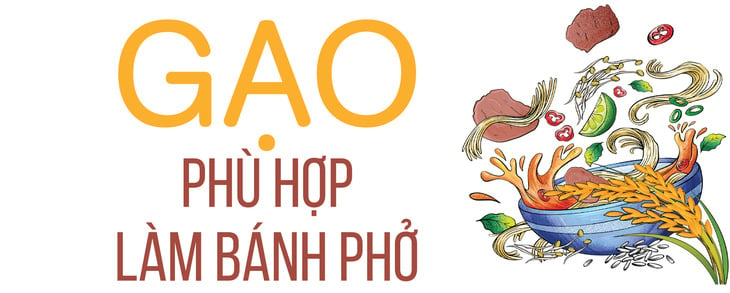
Broth, beef and chicken that are not sold out during the day can still be frozen for the next day, but pho noodles must be used during the day, taken early in the morning, and discarded in the evening if not sold out. Because no matter how delicious the noodles are, after putting them in the refrigerator, the next day when blanched in boiling water, the noodles will break.
Only after learning about the profession of making pho noodles can we see that this ingredient seems simple but is very "complicated". During the Pho Day event on December 12, I heard some people wonder "Vietnam has ST25 rice that won the award for the best rice in the world , why not make pho noodles from that rice to promote pho to make it more attractive in terms of marketing?".
But two characters who stood side by side with the events of Pho Day 12-12 in the act of building a kiln to make pho noodles right at the festival, Ms. Thanh Nguyen (Pho Hai Thien) and Mr. Vu Ngoc Vuong (Pho Ngoc Vuong) both said: The rice that is more sticky and more delicious cannot be used to make pho noodles. The rice used to make pho noodles is old rice, expands a lot, and is spongy.

Ms. Thanh Nguyen, born into a family that has been making pho noodles for a long time in Binh Thuan with the name Hai Thien, also agrees with Mr. Vuong that Doan Ket rice is the top rice for making pho noodles.
"I love this profession so I travel all over the country to learn about pho in general and pho noodles in particular. In the South, the most popular type of rice to make pho and vermicelli is IR504, which is quite cheap and very profitable to use to make pho and vermicelli.
But to make delicious pho noodles, I use Ham Chau rice, which is quite expensive. After trying it over and over again, I finally decided that Doan Ket rice from Cao Bang is the easiest and most delicious to make," she said.
The issue of pho noodles also causes headaches for pho business people abroad. Tony Cao Van Luan, owner of two pho restaurants in Melbourne (Australia), said he understands that a bowl of pho with fresh noodles is definitely more delicious than dry noodles, but when he went to Australia, the US, Japan..., he found that the shop owners all had difficulty with one thing: making fresh pho noodles as delicious as in Vietnam is impossible for a simple reason - there is no suitable rice.

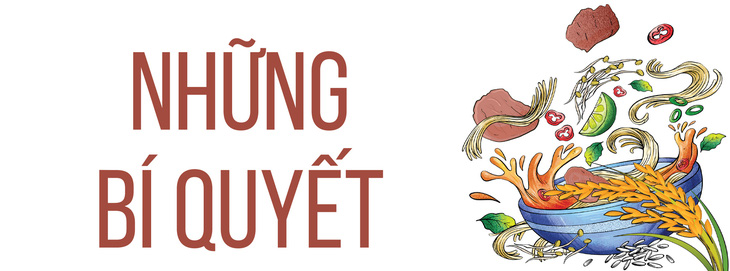
The secrets to making pho noodles in a unique way, when shared, also show a lot of research. A woman with many years of experience in the pho profession, at the press conference of Pho Day, revealed: "No matter what kind of rice, when grinding the flour, there must be a little cold rice mixed in for the pho noodles to be chewy."
Mr. Ngoc Vuong said that the secret is correct but only for old-style rice varieties, with suitable rice like Doan Ket, Bao Thai... it is not necessary.
What he cares about most is how, after blanching the noodles, putting them in a bowl and pouring the broth over them, within 15 minutes (equivalent to the time it takes for customers to finish eating), the noodles will not become mushy or broken.
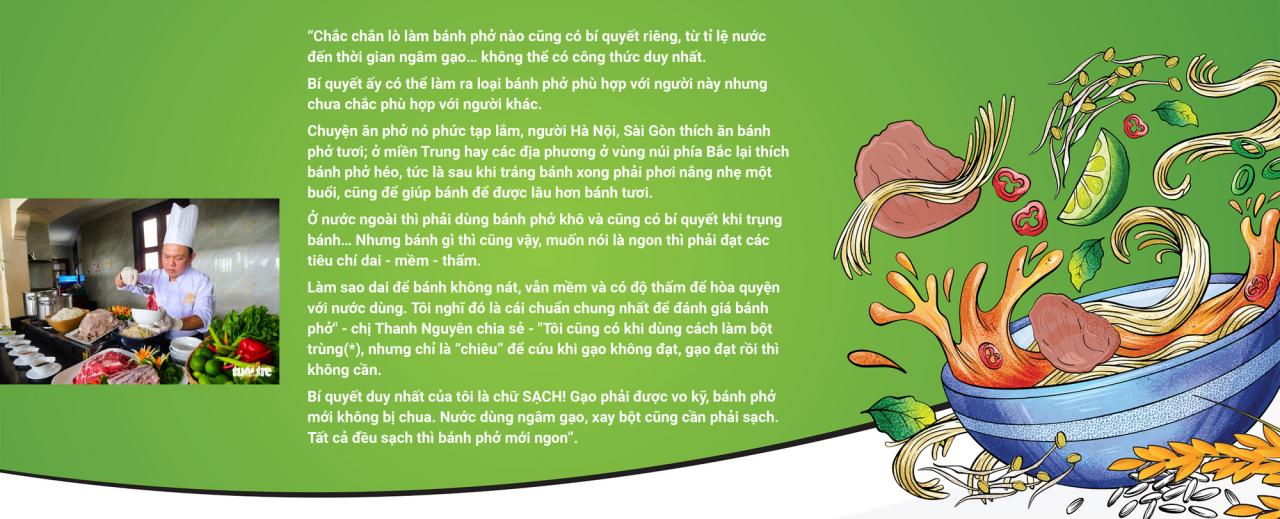
At the Vietnamese Pho Festival in Japan on October 7 and 8, Ms. Thanh Nguyen attended with her own booth. Although she could not get fresh pho noodles to serve at the festival, she had her own way to ensure the quality of the pho she served. "For me, of course, using fresh pho noodles is still the best.
But now the technology to make dry pho noodles is also very high quality, just need to handle well when processing, it is also 9/10 compared to fresh pho noodles.
I learned how to process dry pho from Vietnamese chefs in the US, because they specialize in dry pho so they have more experience, mainly soaking the dry noodles in water for at least 30 minutes, this is something few chefs in the country do. After blanching the noodles in boiling water, transfer them to cold water.
It is especially important to note that from the cold water, each pho noodle must be taken out and divided into small pieces, not put in the same basket, which will make the noodles easily stick together and break. If you are so careful, the quality of the dried pho noodles will not be much different from that of the fresh noodles."
(*) Pasteurized flour is a folk method used to save flour when it is not elastic or chewy. Take the flour itself, squeeze out a handful of it, depending on how elastic you need it to be, boil the dough, then knead and grind (depending on the type of cake) together with the batch of dough.
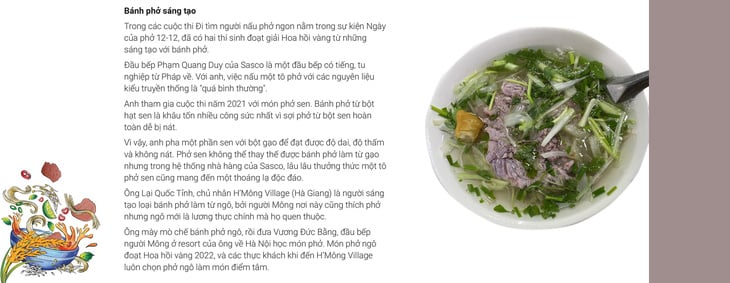

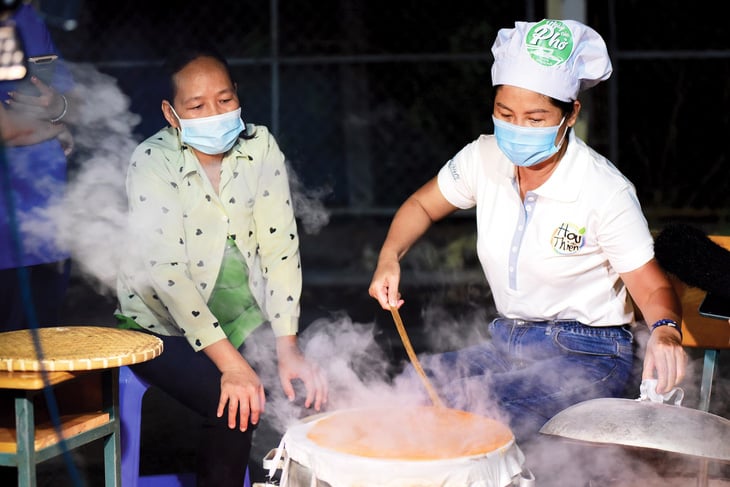
Ms. Thanh Nguyen (Pho Hai Thien) instructs how to make pho noodles in Thieng Lieng (Can Gio, Ho Chi Minh City) in the program Pho Day 2021. Not only making traditional pho noodles, she is also famous for making colorful pho rolls and mixed pho from vegetables and fruits - Photo: Duyen Phan
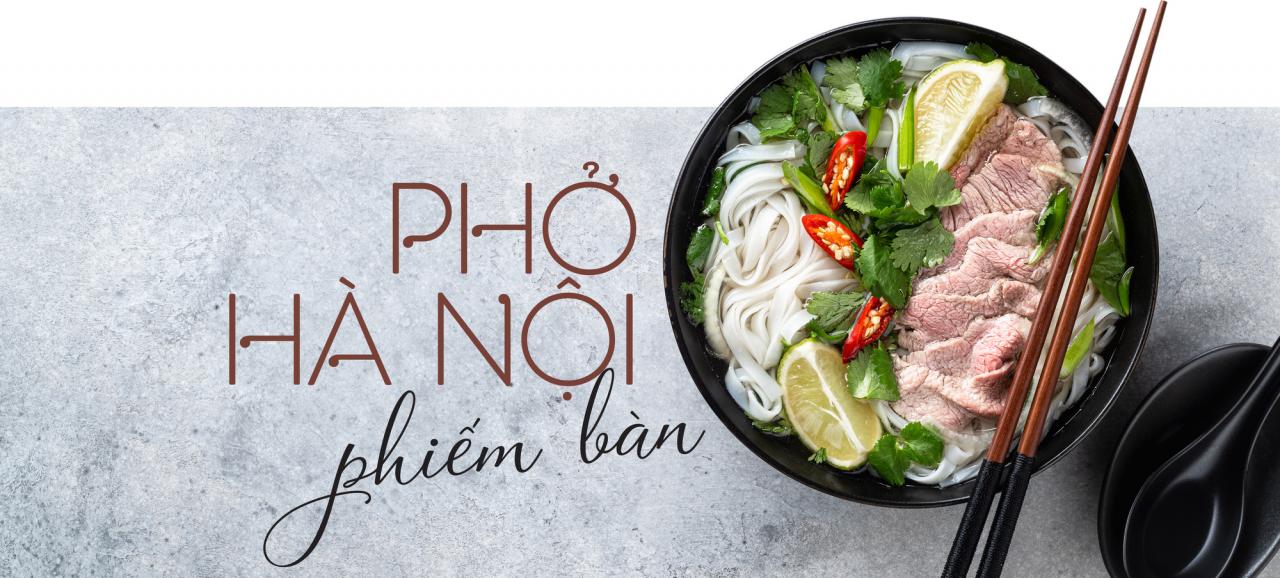
A friend of mine who immigrated to Saigon a long time ago complained on Facebook: "Today in Saigon, there is low pressure. The rain is cold and long like the drizzle in the North. A bowl of beef noodle soup is the best at this time of year."
There are plenty of Northern pho restaurants in Saigon. But today you miss Hanoi pho. Then go home, go home and listen to the wind of the Red River blowing, and smell the pho of the past.
Whether it's state-owned pho, "manned" or "unmanned" pho, people still remember the smell of cloves, cardamom, and the taste of beef brisket in the wind blowing from the past, haunting the soul.
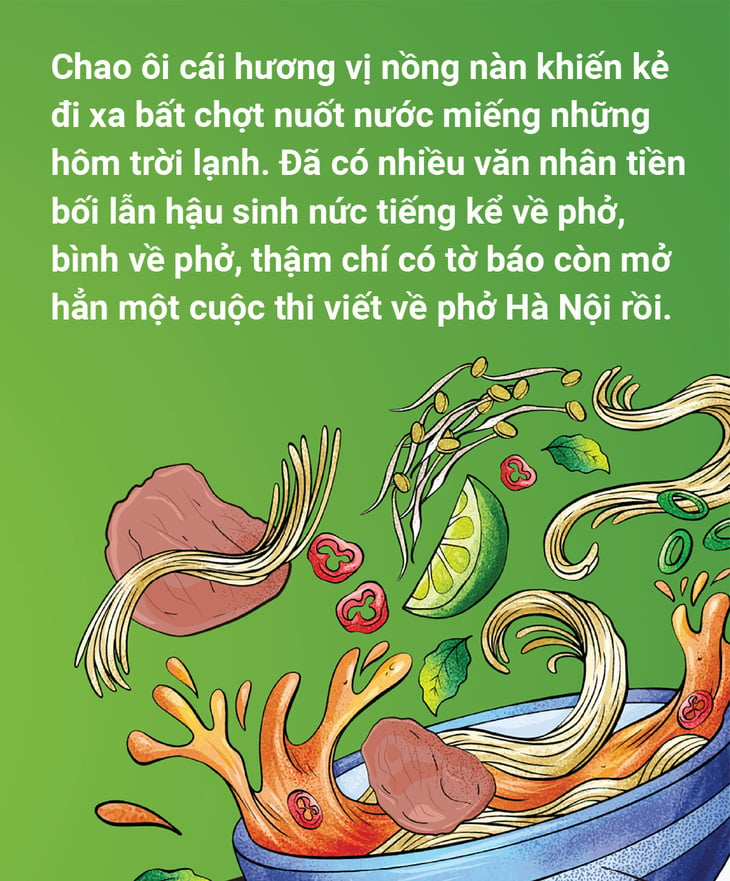
This article is considered to contribute a personal perspective on a fragrant gift from a pot of broth boiling ecstatically early in the morning on the street, fragrant even in the pages of books praising it.
First of all, it must be affirmed that each of us has a different personality, each person has a different opinion as well as culinary taste, and therefore it is completely normal if each person is a "fan" of a different pho restaurant. Here I will only talk about the pho restaurants that I know.
One of these pho shops is Pho Tu Dn on Hai Ba Trung Street. The broth of this pho shop is not filtered but has the rich taste of stewed bones.
Freshly chopped rare beef mixed with a few pieces of ginger spread thinly on the bowl, boiling broth poured over, the rare beef slices turn a light pink color, sweet and soft, accompanied by a few large, crispy, fragrant, cooked brisket slices. Chili sauce with a small spoon of garlic vinegar, seasoned to taste.
The first spoonful of water must be slurped and blown on carefully, because if one is hasty and lacks self-control before the allure of the flavor, one will choke miserably.
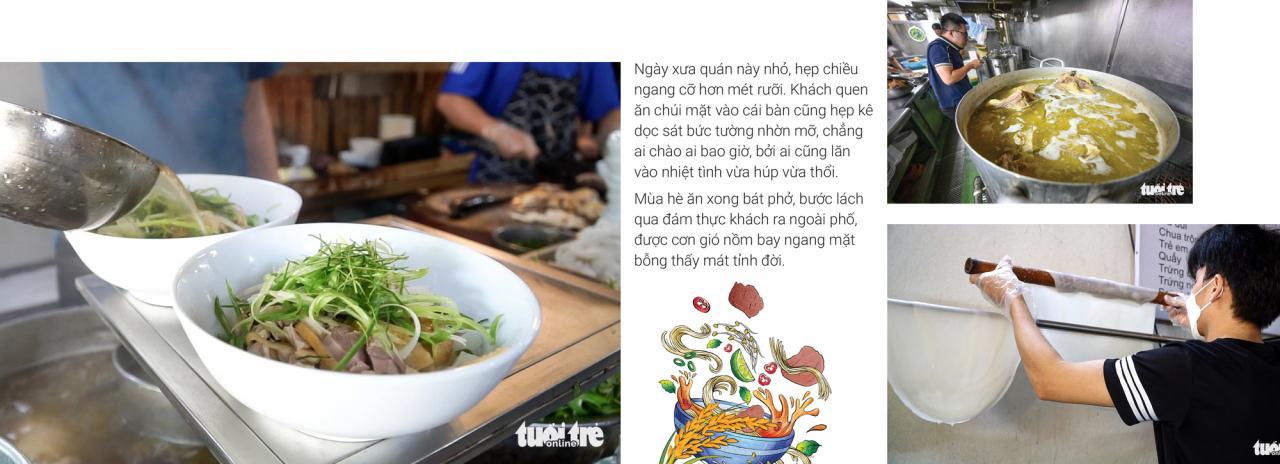
Another special feature of Pho Tu Dwarf is that the spring onions are thinly sliced like the onions used in fried tofu with fish sauce and sugar, with a few sprigs of Lang basil, coriander leaves, and a few stalks of white, lightly blanched spring onions.
Mr. Nguyen Tuan used to say that pho had to be eaten standing up and slurping, if I'm not mistaken, it was also to describe this cramped pho shop.
The two female students from a nearby high school were chattering and looking in the mirror to see if they had any green onions in their teeth after eating his famous "Pho Essay". They were definitely female students from Trung Vuong High School on Hang Bai Street right there, not any other school.
After Mr. Tu was offered a "public-private joint venture" to work with the state-owned pho restaurant in the early 1970s, he was praised by the Hanoi Moi newspaper at that time, an article that I read.
He went to work as a technician for the North-South food trading store on Ngo Quyen Street. He thought that from then on, the secrets of the fragrant, fragrant pho would belong to all the working people. However, after the "Joint Venture" season came the "Innovation" season, he returned to open his own restaurant.
Until now, Huy and Lan's children have continued his career. Like him, none of them are tall, but that doesn't mean the pho restaurant lacks fans.
After many years of saving, they have doubled the width of the restaurant, and dining tables can now be placed in a row, although on the sidewalk there are still customers eating on plastic chairs.
I like to sit and eat on plastic chairs outside. Every morning when the ward police drive their cars past and use loudspeakers to remind customers, the diners push their chairs away, pick up their bowls of pho, stand up, blow and slurp like Nguyen Tuan had said years ago.
Also around Hoan Kiem Lake near Ba Kieu is the famous Pho Thin restaurant. Pho Thin is characterized by its clear, light broth, served in wide-mouthed bowls.
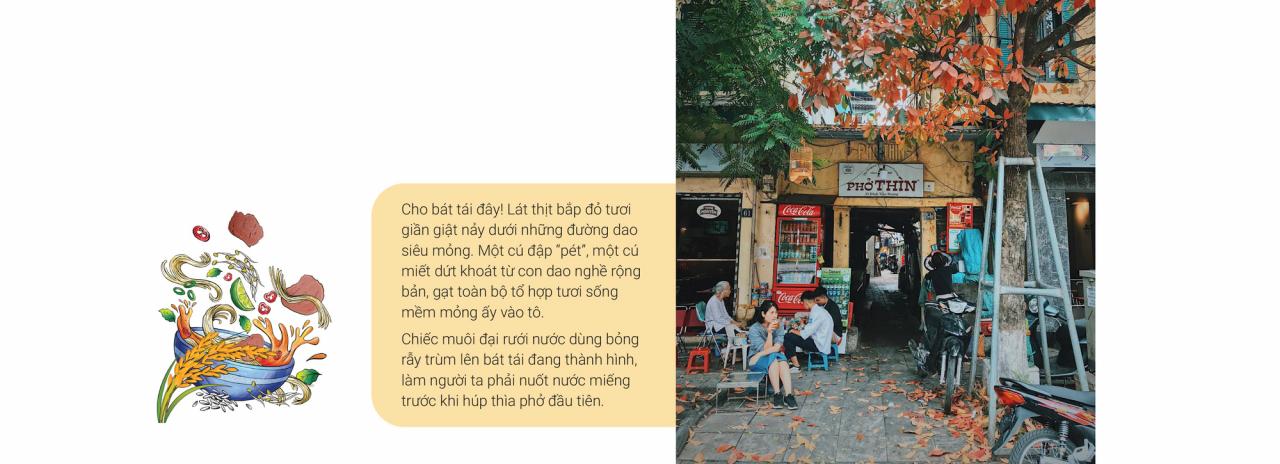
Mr. Thin was also a small and cheerful person. When I was renovating the Hanoi Post Office, I sometimes went to his shop. At that time, he was no longer directly working at the table but still came back and forth to visit.
In the morning, if he had a few small glasses of wine, he would feel inspired and sing a parody of the song "The Boy Silently Entered the Hotel...", making the guests laugh.
The Southwestern border war broke out. Dung, Mr. Thin's son, joined the army in 1978, in the same combat unit as me, in the 2nd company of the 4th battalion on the Cambodian battlefield. We, the Hanoi soldiers, called him with his father's name, Dung "Thin".
Soldiers of a heroic company in a heroic battalion must of course accept the fate of hardship and death. He was wounded in the battle of O Dong coconut forest, went to the hospital and was discharged.
When Dung got home, he got married and asked for permission to open the "Pho Thin" brand on Doi Can street. Dung "Thin" suffered from a serious illness and died early, and Pho Thin Doi Can is probably less known than Pho Thin "Bon Ho". May our soldier friend rest in peace in heaven.
There are many Pho Co stores across the country from the South to the North. Although it is said to originate in Nam Dinh, Pho Co is only famous in Hanoi. In the South, I have not seen any Pho Co stores.
On the contrary, the Pho brand No. 10 Ly Quoc Su Hanoi has opened a sign at No. 6 Ben Ngu Street, one of the busiest streets in the textile city.
With its characteristic large, hand-cut rice noodles and broth rich in the flavor of delicious fish sauce with a little cinnamon, star anise, and cardamom, Pho Co makes it easy for gourmets to recognize both its simple presentation and its rustic yet homely flavor.
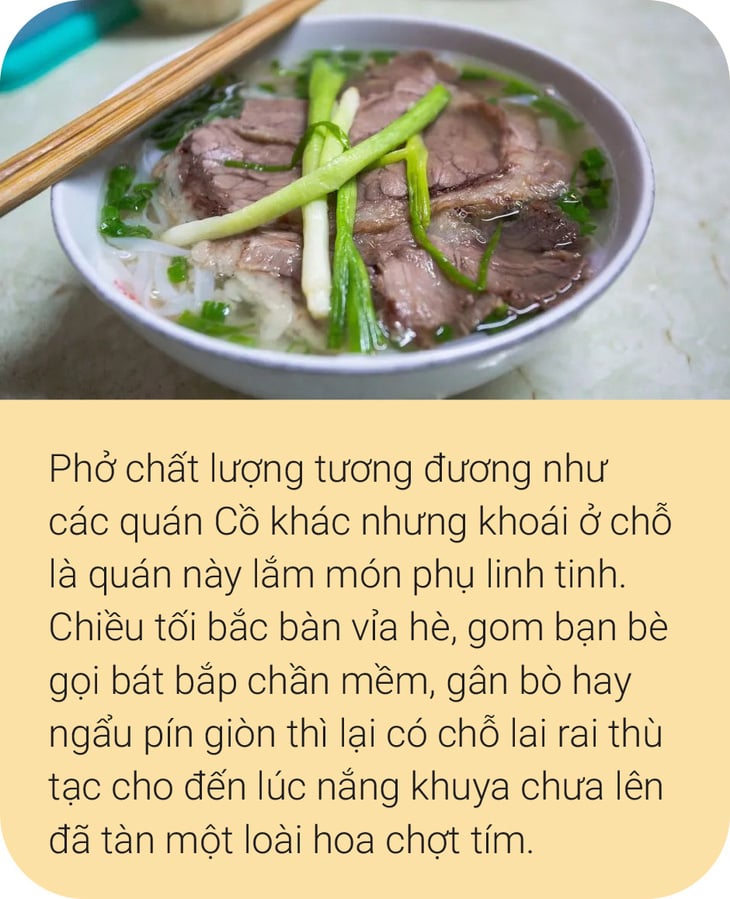
In Hanoi, I know a Co restaurant on Quoc Tu Giam street, a new Co restaurant on Khuat Duy Tien street, I often eat there when I go on business trips because it is near the road to Thanh Tri highway. In my free time, I like the Co Cu restaurant at the beginning of Thuy Khue street near Chu Van An school the most.
I only found out about Pho Lam at the Hang Vai - Cong Duc intersection a few years ago when a friend invited me to eat there. The restaurant is small and the broth is clear because the pho here specializes in blanched corn cobs. The food is delicious, but I have to say that the history and connection with many generations is not as good as other pho restaurants.
The pot of broth must be big, tall, thick, shiny with beef fat on the outside, and must always be boiling on the coal stove to cause trouble for my eyes and stomach. But the shiny, thin aluminum pot of broth easily gives off a makeshift feeling of a small shop at the end of the market.
If I were to name them all, it would take an entire book. But no matter how famous the pho restaurant is, after eating it, you will realize that the most selfless contribution in the world is the nameless chili sauce, vinegar, and garlic.
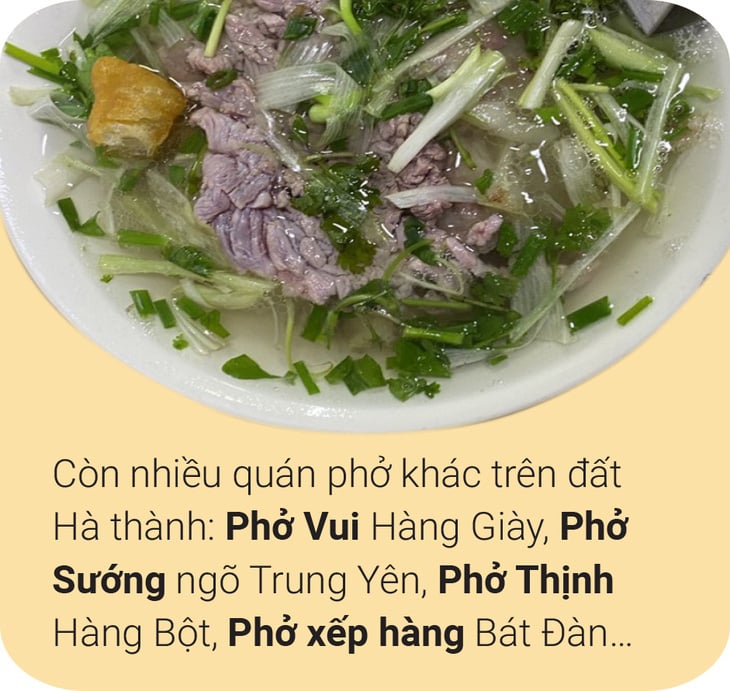
When the broth is good, it contributes to the aromatic flavor. When the broth is bad, it rises to become the main ingredient. Garlic and chili are the force, the embodiment of independent culinary culture. Garlic and chili are the anonymous people.
A few lines of somewhat exaggerated and cheerful banter about Hanoi pho, which may help reduce your boredom caused by excess food.
Actually, planning a menu for the day is more difficult than going to the market. If you can't think of anything to eat on a cold day, we'd better go eat pho today.
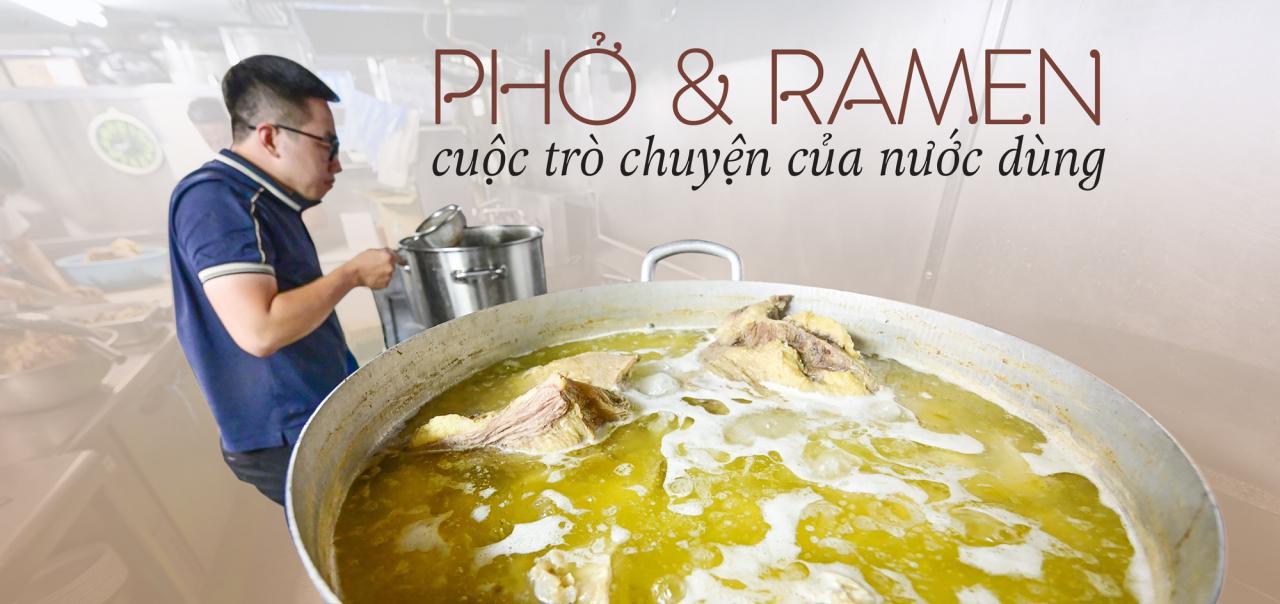
Hours spent watching a pot of simmering bones, occasionally opening the lid to observe the boiling level of the water to adjust the heat of the stove or skimming off the foam to ensure the water is clear.
Then, cover the pot and wait patiently. Those actions look like those of a Taoist refining elixir, but no, they are just boiling a pot of broth.
The broth - often called pho broth (in the North), broth (in the South), and dashi (in ramen) - is the soul of pho and ramen.
It is not a side ingredient of the dish, on the contrary, it is the foundation to create the identity and value of the dish, completely different from other soups or appetizers.
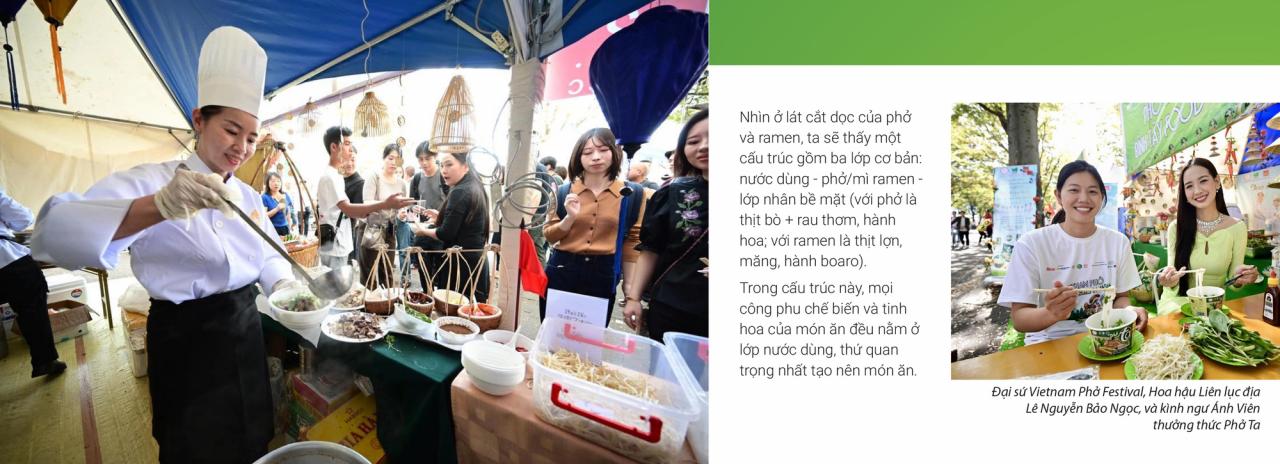
The broth of pho and ramen is no different from other stews, simmered from animal bones/meat to sweeten, creating a fatty, sweet, nutritious liquid.
However, the process of making pho and ramen broth requires more effort and concentration during the preparation process than other broths. It is hard labor.
Almost all famous pho or ramen restaurants are owned by men. This is not sexism at all, it is simply that men are in better health to cook this dish.
Put yourself in the context of when cooking had no support from tools, but relied almost entirely on physical strength and pure technique to understand this.
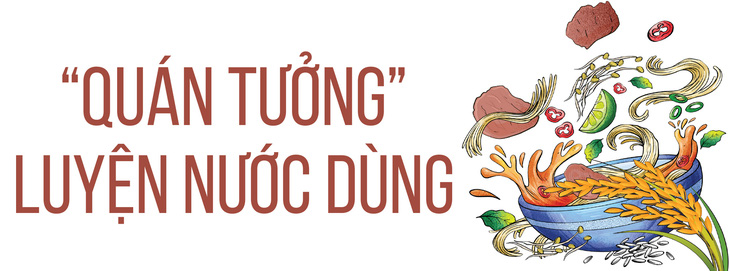
For pho broth, the first thing is to choose a good beef marrow bone, with the precious marrow inside. In addition to the marrow bone, there are also oxtail bones, backbones or ribs, in total, several dozen kilos of bones are needed to cook pho in one day.
Before being simmered, beef bones must be soaked and washed thoroughly. After washing, the bones are placed in a pot with spices such as cinnamon, star anise, cardamom, grilled onions, and ginger, then put on the stove to simmer, starting a patient process.
And it's not a matter of putting a pot of bones on the stove at a fixed temperature for five or eight hours, leaving it there, and then going off to do something else.
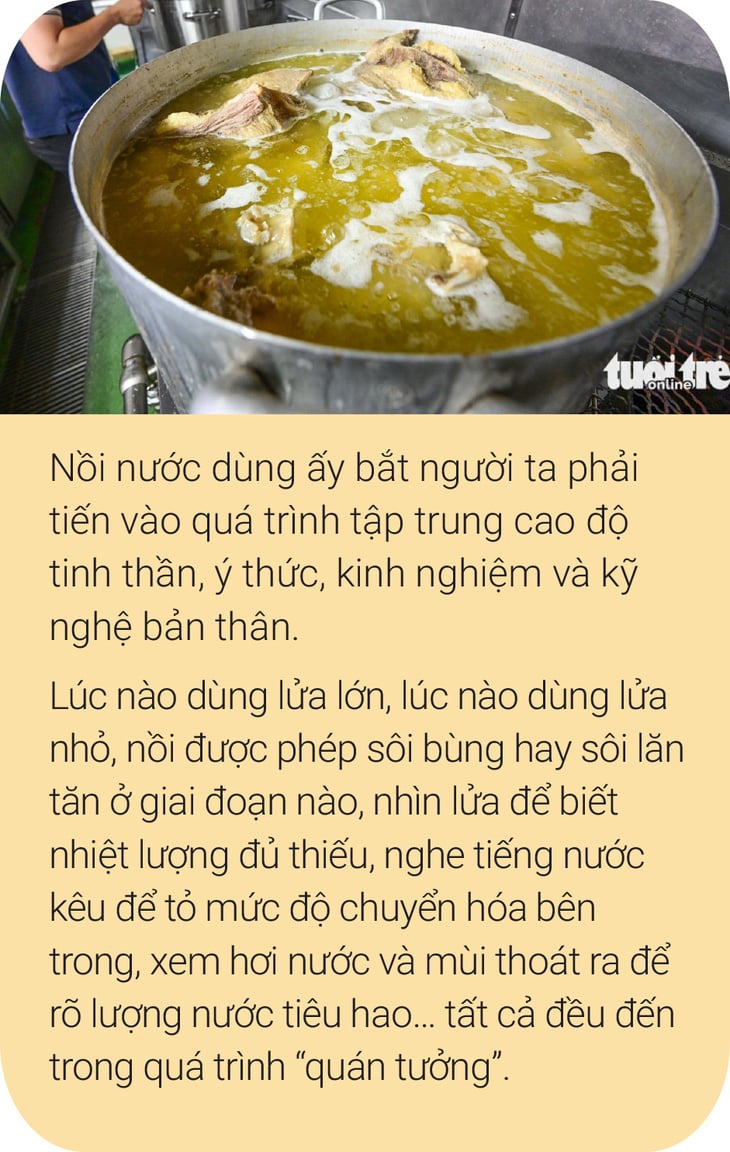
That hard work takes hours, because only then can all the sweet, fatty aromas from the bone tissue and bone marrow be extracted to create a rich, beefy, slightly pungent solution that, if blown a little onto the street, will let passersby know, "Oh, they're making pho here."
The quality of the pho broth will depend on the care and skill of the cook. If a cook lets his mind wander away from the pot of simmering bones, the aroma will be less rich, the taste will be strong or too much, and the broth will not be clear but will have a lot of sediment floating around.
On the contrary, if properly cared for, the pho broth will be clear, with a light amber color, the beef aroma will radiate brightly, and the sweetness will be so thick that you can almost bite it.
Meanwhile, in a kitchen in Japan, a chef is also diligently preparing a pot of ramen broth, a process that also takes about 10 hours.
Dashi is also stewed from bones, dried bonito, kelp... seasoned with tare - indispensable spices for ramen such as soy sauce, miso paste and salt...
The bones are simmered elaborately, divided into six stages, corresponding to six times the bones are simmered, to obtain the final result.
The pig's head bones, trotters and other ingredients are washed, boiled and boiled, then simmered at low temperature for three hours and 8/10 of the water is drained.
Then add water and pork fat and simmer over high heat until the pork fat is completely melted, the broth is reduced by half and begins to thicken like cream.
The bones are then simmered with kelp, dried fish, mushrooms, etc. to create other layers of broth. Finally, everything is mixed together, filtered, and simmered one last time to create a smooth, rich, creamy dashi thanks to the fat and collagen.
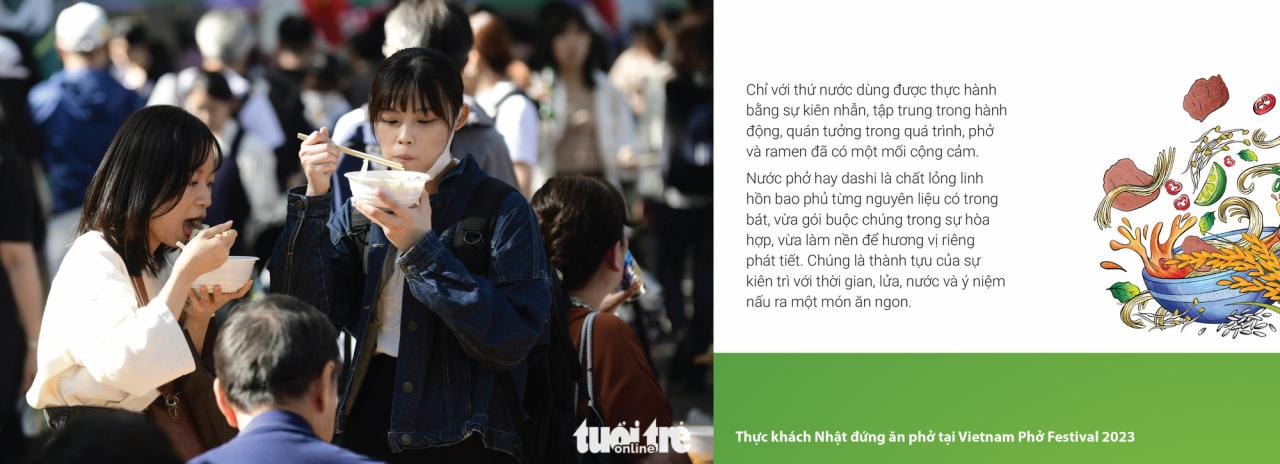

Vietnamese people can eat pho every day, but still crave for bowls of pho that are said to be delicious elsewhere. Because that is probably a sincere love for pho, wanting to satisfy the desire immediately.
The Japanese love ramen in a more reserved, proud way. But both ways come back to the same goal: expressing their love for the food.
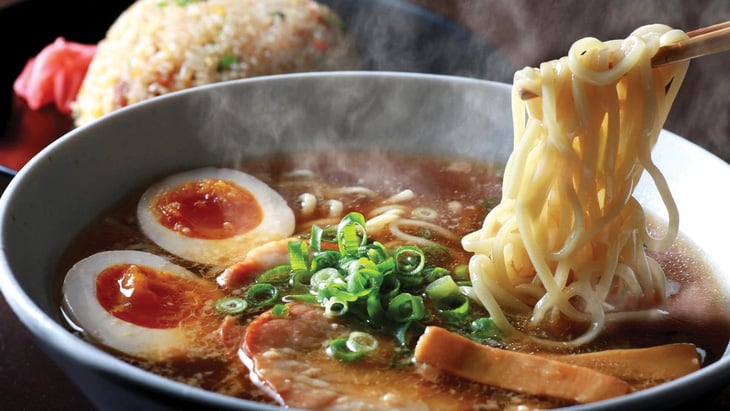
Vietnamese people pay attention to the aroma and taste of a bowl of pho. Of course, we still like to look at a beautiful bowl of pho, but then we will add a little vinegar, garlic, and chili as if to take care of something very important: we must eat pho right away while the heat of the pho is still present, the last bite has been finished but the bottom of the bowl still seems to be floating with a little smoke.
Therefore, the typical Vietnamese way of eating pho is to focus on the bowl of pho, not caring about life outside the bowl of pho, not chatting while eating pho and especially never eating pho while doing other things. You have to start and end eating pho seamlessly.
That can be called a passionate love. One can only live like that with the person one truly loves, devoting all one's time and mind - body - spirit to that love. It is different from eating pho while thinking about other things, different from living together but "sharing the same bed but dreaming different dreams".

A bowl of ramen is enjoyed in a unique "chant" style.
The bowl of ramen is beautifully colorful, the ramen noodles are ivory white and turn yellow, the dashi broth is smooth like milk, rich in flavor, especially the saltiness and umami.
Lying on top of the ramen are slices of tender yet shapeless, melt-in-your-mouth braised pork. Dark brown pieces of dried bamboo shoots (menma) highlight the orange-red color of the soft-boiled egg, with a hint of light green from the leeks.

At first glance, you would think that it is a way to use up the broth, like Vietnamese people use cold rice to eat the remaining pho broth.
But in fact, it is respect for the cook's efforts, respect for a dish that brings many emotions, so not wasting every last drop of broth.
-----------------------------------------------------------------------------------------------------------------------------
Tuoitre.vn


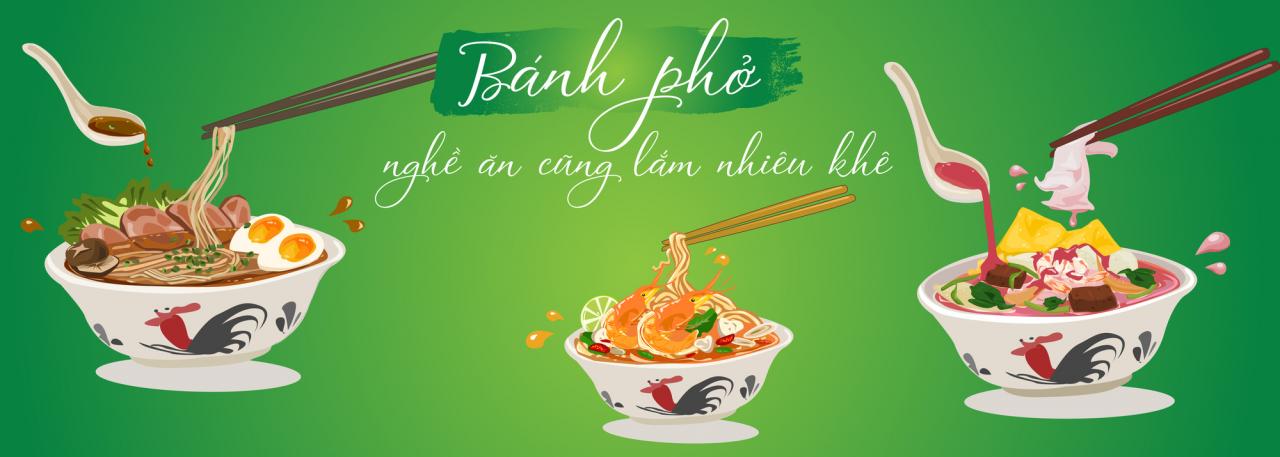
![[Photo] Emotional and proud flag-raising ceremony and military review on Truong Sa island](https://vphoto.vietnam.vn/thumb/1200x675/vietnam/resource/IMAGE/2025/5/31/9b52525fce6f433083cd0a5bfee59f49)


![[Photo] Prime Minister Pham Minh Chinh chairs a Dialogue with businesses and business associations](https://vphoto.vietnam.vn/thumb/1200x675/vietnam/resource/IMAGE/2025/5/31/b606d6f6ff584fa28af9f353c91bf15d)


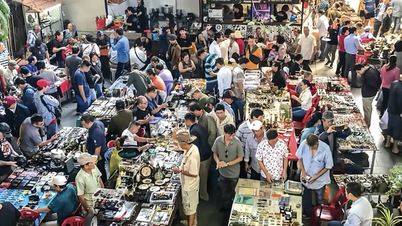





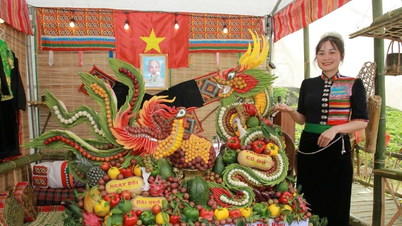











![[Photo] Prime Minister Pham Minh Chinh attends the opening ceremony of the National Law Portal](https://vphoto.vietnam.vn/thumb/1200x675/vietnam/resource/IMAGE/2025/5/31/f02ed6288a4340bdb4adf1b2149b9614)
![[Photo] Launching ceremony and drawing of pairs for the "9th TIM CUP Highland Charity Football Tournament"](https://vphoto.vietnam.vn/thumb/1200x675/vietnam/resource/IMAGE/2025/5/31/a4c145af5d1e48c5b48c95116d41a73c)

































































Comment (0)